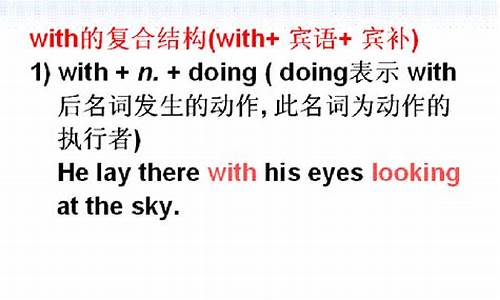您现在的位置是: 首页 > 热门专业 热门专业
高考英语with复合结构,with复合结构高考题
tamoadmin 2024-05-27 人已围观
简介1.with复合结构经典句型2.with 复合结构用法?3.with 的复合结构,现在分词 和过去分词做宾补的区别。4.关于这个with 的复合结构的选择题:5.关于with复合结构的几道英语题 (要解析)这个句子有三个语法上的结构,第一个为“with his eyes fixed on the family album”,也就是with独立主格结构做状语,由介词with+名词his eyes+过
1.with复合结构经典句型
2.with 复合结构用法?
3.with 的复合结构,现在分词 和过去分词做宾补的区别。
4.关于这个with 的复合结构的选择题:
5.关于with复合结构的几道英语题 (要解析)

这个句子有三个语法上的结构,第一个为“with his eyes fixed on the family album”,也就是with独立主格结构做状语,由介词with+名词his eyes+过去分词短语fixed on the family album构成。
第二个结构为定语从句,即he had when he lived with his parents.修饰前面的名词the fun.
第三个结构为上面定语从句中的时间状语从句 when he lived with his parents.
主句构成为:he主语;thought of 谓语;the fun名词作宾语。
with复合结构经典句型
with的8种复合结构用法例句如下所示:
1、with +宾语+名词
He died with his daughter a schoolgirl.他在他女儿是个小学生的时候死了。
2、with+名词(或代词)+补语
He wondered if he could slide out of the lecture hall without anyone noticing.他想他是否可以在没有人注意到他的情况下悄悄溜出演讲大厅。
3、with +名词(或代词)+过去分词
She had to walk home with her bike stolen.自行车被偷,她只好步行回家。
4、with +名词(或代词)+现在分词
With the crowds cheering, they drove to the palace.在人群的欢呼声中,他们驱车来到皇宫。
5、with+名词(或代词)+非谓语动词
With a lot of work to do, he wasn't allowed to go out.因为还有很多工作要做,他没有被允许外出。
6、with+名词(或代词)+介词短语
He walked into the dark street with a stick in his hand.他走进黑暗的街道时手里拿着根棍子。
7、with+名词(或代词)+副词
She left the room with all the lights on.她离开了房间,灯还亮着。
8、with+名词(或代词)+形容词
I like to sleep with the windows open.我喜欢把窗户开着睡觉。
with 复合结构用法?
1、with + 名词 (或代词) + 现在分词
此时,现在分词和前面的名词或代词是逻辑上的主谓关系。例如:
With prices going up so fast, we can't afford luxuries. 由于物价上涨很快,我们买不起高档商品。(原因状语)
2、with + 名词 (或代词) + 过去分词
此时,过去分词和前面的名词或代词是逻辑上的动宾关系。例如:
I sat in my room for a few minutes with my eyes fixed on the ceiling. 我在房间坐了一会儿,眼睛盯着天花板。(伴随情况)
3、with + 名词 (或代词) + 形容词
I like to sleep with the windows open. 我喜欢把窗户开着睡觉。(伴随情况)
4、with + 名词 (或代词) + 介词短语
With the children at school, we can't take our vacation when we want to. 由于孩子们在上学,所以当我们想度假时而不能去度假。(原因状语)
5、with + 名词 (或代词) + 副词
He fell asleep with the light on. 他睡着了,灯还亮着。(伴随情况)
6 、with + 名词 (或代词) + 动词不定式
此时,不定式表示将发生的动作。例如:
With no one to talk to, John felt miserable. 由于没人可以说话的人,约翰感到很悲哀。(原因状语) 扩展资料 1.With the crowds cheering, they drove to the palace. 在人群的欢呼声中,他们驱车来到皇宫。(伴随情况)
2.She had to walk home with her bike stolen. 自行车被偷,她只好步行回家。(原因状语)
3.With the weather so close and stuffy, ten to one it'll rain presently. 大气这样闷,十之八九要下雨。(原因状语)
4.The soldier had him stand with his back to his father. 士兵让他背朝着他的父亲站在那儿。(行为方式)
with 的复合结构,现在分词 和过去分词做宾补的区别。
I、 with复合结构作状语
With + 名词 + 介词短语
(1)他头枕在胳膊上睡了。
He was asleep with his head on his arm. 作伴随状语
(2)这人手里拿了一个鞭子进来了。
The man came in with a whip in his hand. 作伴随状语
在书面语中。上句也可以说成:The man came in, whip in hand.
2、with + 名词 + 形容词 (强调名词的特性或状态)
(1)天气这么闷热,十之八九要下雨。
With the weather so close and stuffy, ten to one it 'll rain presently. 作原因状语
(2)他过去常常窗子开着睡觉。
He used to sleep with the windows open. 作伴随状语
3、 With + 名词 + 副词
(1)约翰走了,我们的地方大了一些
With John away, we have got more room. 作原因状语
(2)所有的灯都亮着,广场看上去比以往更漂亮了
The square looks more beautiful than ever with all the lights on. 作原因状语
4、 With + 名词 + -ed 分词 (强调名词是 -ed分词动作的承受者或动作已经发生)
(1) 随着这个问题的解决,新霉素一号现在已正式生产。
With this problem solved, neopenicillin 1 is now in regular production. (作时间状语)
(2)把手机关机,你就可以进入教室上课。
You can attend the class with your cellphone powered off. (作条件状语)
5、 with + 名词 + -ing分词(强调名词是 -ing分词的动作的发出者或某动作,状态正在进行)
(1)妈妈生病了,我不去度假了。
I won’t be able to go on holiday with my mother being ill. (作原因状语)
(2)整个班上的学生盯着他看,他感到更不安了。
He felt more uneasy with the whole class staring at him.(作原因状语)
6、 with + 名词 + to do (不定式动作尚未发生)
(1)由于下午无事可做,我就去书店转了转。
So in the afternoon, with nothing to do, I went on a round of the bookshops. (作原因状语)
(2)由于这么多碗没洗, 我不能出去。
I can't go out with all these dishes to wash. (作原因状语)
关于这个with 的复合结构的选择题:
答案选A
从你问的with复合结构以及fix这个经典词来看,你应该不是学生
第一空填was seated太明显了,你似乎也并未纠结于此,不赘述
第二空实在是经典中的经典:
He was seated on the bench,with his head down and his eyes fixing on the ground.
He was seated on the bench,with his head down and his eyes fixed on the ground.
上面两句都对。
fixing是vi.,不及物动词无被动,主动进行表伴随和持续。
fixed是vt.,及物动词有被动,表被动和完成;又因fix是短暂性动词,所以不用being fixed;而且fix的意思是”锁定,固定“,本身有持续的意思,所以也可不用进行式
至于为何总有些无聊的题,非要从fixing和fixed中来个二选一,我只想说,真正的高考真题是木有这么无聊的,绝对不会单考二者区别(可以自己查查历年真题i)。
那为何有无聊的题呢?
一切起源于fix one's eyes on这个短语;因为它是高中一个知识点,所以有人就出了个考察fix做vt.及物动词的考题,引导学生选fixed;这在单元测试题里常见,只能说明出题人狭隘
而像你给出的这道题,fixing做的是vi.,也是标准用法,但此题质量就高多了,毕竟第一空就限定了答案,否则又是个无聊题
综上,fixing or fixed?这和with复合结构一点干系都木有,相信自己的语法积淀,是题目出的有歧义,不是自己的思路问题
关于with复合结构的几道英语题 (要解析)
答案是D, 因为with的复合结构,to do 主动表被动,表将来。淡水和干净水与供应之间的关系是被动的,所以从A和D中选,A中是被动但是表示完成,D是被动表示进行,淡水和干净水应该是一直被供应,所以是个进行时态,所以选D
前面为答题,后面为with的用法详解
1.With a lot of things______(do), he had to stay there for another day.
- to do 表示“未做、待做”
动宾关系这种关系主要是由with独立主格结构中的名词和其后的过去分词及动词不定式构成的,前者表示“被动、完成”,后者表示“未做、待做”。
有这么多工作要做,他不得不多停留一天。
2.With a latter______(post),he has to go to the post office.
- to post 表示“未做、待做”
动宾关系这种关系主要是由with独立主格结构中的名词和其后的过去分词及动词不定式构成的,前者表示“被动、完成”,后者表示“未做、待做”。
为了寄一封晚到的信件,他不得不去邮局。
3.With the work______(do),she went home.
- to do 表示“未做、待做”
动宾关系这种关系主要是由with独立主格结构中的名词和其后的过去分词及动词不定式构成的,前者表示“被动、完成”,后者表示“未做、待做”。
带着要做的工作,她回了家
楼下的done也有一定道理
- done 表示“被动、完成
她做完了工作,回家
4.With you ______(help) us, we will finish the task in time.
- helping
主谓关系这种关系主要是由with独立主格结构中的名词和其后的现在分词构成。
有了你的帮助,我们将及时完成任务
5.With the boy_______(lead) us, we found his house.
- leading
主谓关系这种关系主要是由with独立主格结构中的名词和其后的现在分词构成。
男孩带着我们,找到了他家
- - -
WITH独立结构在句中作为状语,
现将with引导的独立主格结构总结如下。
一、句法结构
结构一 with +名词(代词)+介词短语
例1 He sat there thinking, with his chin on his hand.
他手托下巴,坐在那儿沉思。
结构二 with +名词(代词)+形容词
例2 He stared at his friend with his mouth wide open.
他张大嘴巴凝视着他的朋友。
结构三with +名词(代词)+副词
例3 With production up by 60%, the company has had another excellent year.
产量上升了60%, 公司又是一个好年景。
结构四 with +名词(代词)+名词
例4 She used to sit reading in the evening with her pet dog her only companion.
她从前总爱在晚上坐着看书,她的宠物狗便是她唯一的伙伴。
结构五with +名词(代词)+现在分词
例5 She stood there chatting with her friend, with her child playing beside her.
她站在那儿跟朋友闲聊,孩子在旁边玩。
结构六with +名词(代词)+过去分词
例6“I think we can leave with our heads held high,” Eriksson said.
“我认为我们可以高昂着头离开,”艾里克松说。
结构七with +名词(代词)+不定式
例7 With 10 minutes to go, you’d better hurry.
还有十分钟,你最好快一点。
二、句法功能
作状语 with独立主格结构主要用作状语,可以表示伴随、方式、原因、时间等。
例8 With Mary to help him, he is sure to succeed.
有玛丽的帮助,他一定能成功。
作定语 主要是用作后置定语。
例9 The girl reached a river bank with so many flowers on both banks.
这个女孩来到了两岸开满鲜花的河边。
三、句法关系
主表关系 主表关系这种关系主要是由with独立主格结构中的名词和其后的形容词、副词以及介词短语构成。
例10 Mother looked at me with tears in her eyes.
妈妈眼含泪水看着我。
主谓关系这种关系主要是由with独立主格结构中的名词和其后的现在分词构成。
例11 With night coming on, we started for home.
夜幕降临,我们动身回家。
例12 The boy lay on the grass, with his eyes looking at the sky.
小男孩躺在草地上,两眼望着天空。
动宾关系这种关系主要是由with独立主格结构中的名词和其后的过去分词及动词不定式构成的,前者表示“被动、完成”,后者表示“未做、待做”。
例13 With so much work to do, we had to sit up through the night.
有这么多工作要做,我们不得不彻夜不眠。
四、句法省略
省略特征 with独立主格结构中的省略主要是指在“with + n + 介词短语”结构中的省略,其特点是省去with及介词短语中的名词修饰词,也就是:“n + 介词 + n”。
例14 She ran to the hero, flowers in hand.
她手里拿着鲜花跑向这位英雄。









